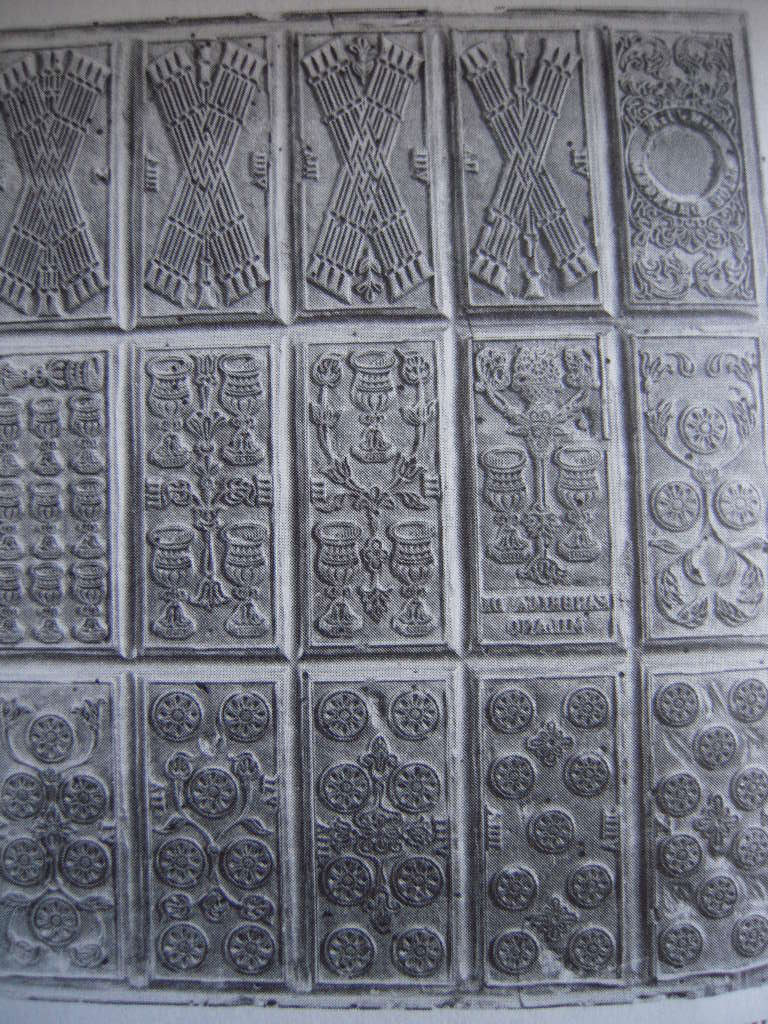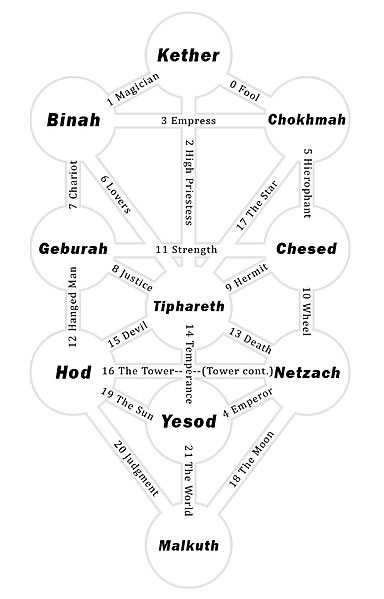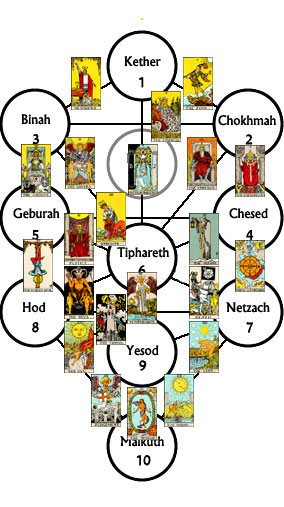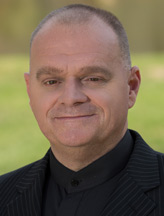Tarot, the Kabbalah, the Tree of Life, and Hermeticism by Psychic Donovan
Date 8/31/2025
Explore More:
Tarot Psychic Tools World Cultures
You are likely familiar with the Tarot, but have you ever stopped to wonder about its origins and why Tarot is so often associated with Kabbalah (aka Cabala or Qabalah) and the Tree of Life? Clearly there must have been some sort of merging of Tarot and the Tree of Life at some point. What was this merger about and why did it happen? What is also interesting is how one of the world's most popular Tarot decks, the Rider-Waite-Smith Tarot deck, keeps getting associated with the Hermetic Order of the Golden Dawn. Who is this group and how are they connected to the Rider-Waite-Smith Tarot deck? Let’s answer these questions now!
The Tarot and Its Rich History

Tarot refers to a deck of 78 pictured cards which most people associate with Gypsy fortune-tellers. Scholars I know keep trying to trace Tarot’s origins back to the Egyptians, and they have done a fantastic job.
Personally, I always think of my late grandmother and her Tarot and Coin shop in Concord, CA, circa the late 1960s, cigarette out the corner of her mouth, room filled with women in beehive hairdos, and my sister and myself in the corner trying, but also not trying, to behave.
Tarot made its first noticeable appearance in 13th-century Milan and then migrated to France in the still-available Marseilles deck. At that time, Tarot cards were produced on leather and metal (as shown here), as the invention of paper was in its infancy.
The 78 Tarot cards are composed of two groups: the Major Arcana (Arcana, arcane, meaning "secret," "esoteric," or "hidden away"), of which there are 22 (starting at card 0 and going up to 21). And the Minor Arcana, of which there are 56 cards divided equally into 4 suits with 13 cards each. Hence, we have the "great secrets," the Major Arcana, and the "small secrets," the Minor Arcana.
The Tarot and Kabbalah
The Tarot eventually became associated with the Holy Kabbalah (Kabbalah, Cabala, and Qabalah), and the Kabbalistic Tree of Life. Mostly because the astrological, numerical, and sacred geometry attributions on the Tarot cards matched corresponding attributions attached to the Kabbalistic Tree of Life. Additionally, the four suits of wands (clubs), cups (hearts), swords (spades), and diamonds (pentacles) corresponded exactly with the four letters of the Tetragrammaton: Yod-Heh-Vav-Heh, which is a foundational theological inflection upon which Judaism and Christianity are structured.
These two giants of metaphysical thought (Tarot and Kabbalah) came together to the great enhancement of the Tarot cards thanks to the French cartomancers, mesmerists, occultists, and students of Hermeticism who were forming up into esoteric lodges in the early 1800s throughout Europe.
Eliphas Levi, a French author, Freemason, and purveyor of esotericism and Hermeticism, wrote the chief influential treatise on the history of western occultism, Dogma and Ritual of Transcendental Magic, published in 1856. Levi’s synthesis of Hermeticism (Astrology, Alchemy, Kabbalah/Qabalah, Theurgy, and Tarot) became the new model for European teachings. Levi was one of the first to associate each Tarot Major Arcana card with a letter of the Hebrew alphabet and place all 78 cards on the Tree of Life. His teaching that the four Hebrew letters of God’s name are supreme words of power (the Tetragrammaton mentioned above) was used as the basis for a complete system of Tarot correspondences. When Levi’s ideas migrated across the English Channel they were adopted by the Hermetic Order of the Golden Dawn and the marriage of Tarot, Kabbalah, and the Tree of Life spread in popularity.
Kabbalah and The Tree of Life
Kabbalah is a form of Jewish mysticism, and like the Tarot, it is best demonstrated visually. This visual portrayal is given in a diagram known as the Kabbalistic Tree of Life. The structure is organized around a set of numbered circles known as sephiroth. Each sephiroth represents an aspect of God.

There are several structures within the Tree. I know they look confusing, but once defined they make sense.
- The right-hand column is called the Pillar of Mercy, and it is the male/active/positive side.
- The left-hand column is called the Pillar of Judgement, and it is the feminine/passive/negative side.
- These “opposites” are reconciled in the Middle Pillar or Pillar of Mildness.
- Nine of the ten sephiroth are arranged on the tree to form three triangles. In each triangle, two opposing factors are balanced by a third.
- At the base of the Tree is a single sphere, Malkuth, which represents the material world. The meaning of the entire Tree pours through Yesod, the “spout,” into Malkuth, where it is made manifest.
- Lines running between the sephiroth represent twenty-two paths. They form a spiritual ascent from the Kingdom, or world of man, at the bottom, to the Crown of God at the top. Each path is assigned a Hebrew letter.
- The paths are numbered from the top down, beginning with Path 1 (from Kether to Chokmah), and ending with Path 22, (from Yesod to Malkuth).
The paths connecting the sephiroth have been assigned so many ways by different authors. The assignment listed above was influenced by Hermeticism and Talmudic literature and is held as being the most useful because it aligns Tarot, Astrology, Geometry, and Numerology with the Tree of Life as the backbone, as defined by the aforementioned Eliphas Levi.
What Is Hermeticism?
I have referenced Hermeticism as being one of the progenitors of the marriage of Tarot and the Tree of Life. But what the heck is Hermeticism? Hermeticism and Hermetica literature are umbrella terms for a grouping of texts attributed to a Hellenistic figure named Hermes Trismegistus, a syncretic combination of the Greek god Hermes and the Egyptian god Thoth. These texts vary in content and purpose, and are divided into two main categories, the “technical” and "religio-philosophical" Hermetica.
The category of "technical" Hermetica encompasses a group of texts that focused on Alchemy, Astrology, Theurgy, Kabbalah, and Numerology. Many of the texts belonging in this category were later translated into Arabic and Latin, often being extensively revised and expanded throughout the centuries. The science and mystery and antiquity of these texts absolutely attracted the French cartomancers, mesmerists, occultists who eventually tied Tarot with the Tree of Life.
The "religio-philosophical" category of Hermetica is broader and encompasses anthropology, cosmology, and theology. A good portion of these texts have been reworked and revised to focus upon a medieval text called the Emerald Tablet and Seven Hermetic Principles.
The Connection Between Hermeticism and The Rider Waite Tarot Deck

Early 1888, two Londoners named William Westcott and Samuel L. MacGregor Mathers launched the Hermetic Order of the Golden Dawn. This short-lived group attracted artists and intellectuals and became a stem-cell of sorts for subsequent esoteric lodges in the English-speaking world. The Golden Dawn’s complex Tarot teachings included tables of correspondences, use of Tarot in rituals for personal and spiritual development, and elaborate spreads for divination. For these folks “magic” was the process of using ritual to focus willpower and attitude in hopes of creating change in one’s personal life.
The Hermetic Order of the Golden Dawn clarified Eliphas Levi’s assertions by assigning the first letter of the Hebrew alphabet to the Fool, thereby assigning all subsequent correspondences to the remaining Major Arcana cards. They also switched the Strength and Justice cards to make these correspondences aligned with Astrology and Numerology. The Knight became the most powerful court card, the King was demoted and renamed the Prince, and the Pages became Princesses. Following Levi’s assertions, the ten numbers of the Minor Arcana cards were associated with the sephiroth on the Tree of Life and were also associated with the 36 decans of the horoscope wheel and the 72 Kabbalistic angels. The trumps, as mentioned above, were assigned to the pathways on the Tree of life.
In 1889, under the pseudonym Grand Orient, an American born poet named Arthur Edgar Waite published A Handbook of Cartomancy, Fortune-Telling and Occult Divination, one of the first books in English on how to read Tarot. Waite’s fascination with the Golden Dawn’s teachings and the occult scene drew him into membership in the Hermetic Order of the Golden Dawn in 1891, but his spirituality gradually evolved away from ceremonial magic and toward Christian mysticism in 1893.
In 1909, Waite created the Rider Waite Tarot in collaboration with Pamela Colman Smith, and authored the accompanying book, The Pictorial Key to Tarot. My suspicion is that Pamela had to do most of the work because from 1901 to 1909 Waite was one of the executive managers for Horlick Malted Milk which had just moved back to the UK from the States, and he had a family to feed and raise. Pamela Colman Smith, however, was a tried-and-true super-producer when it came to publishing esoteric topics; prior to working with Waite, she had done a handful of projects for Bram Stoker, Jack Yeats, and William Butler Yeats, all of whom she knew from the Hermetic Order of the Gold Dawn.
Tarot and Kabbalah – Bringing It All Together
So, what does this all mean to you? And does any of this history matter? No. History will always be changed and rewritten by those who like to hear themselves talk. This history brief tells us that although Tarot and Kabbalah may be divinely inspired, with plenty of natural harmony, their different manifestations are clearly human. The best Tarot deck to use is the one that stands out to you, the deck that strikes a spark of attraction. The most effective Tarot readers are screened and trained and are found right here at Psychic Source. My suggestion is to mix the two. That is, pick a deck that appeals to you and discuss it with your go-to Psychic Source Tarot reader.
 Get a Reading with Donovan x8351
Get a Reading with Donovan x8351
Donovan grew up in a home where the psychic arts and performing readings for others was considered a privilege and a folk art to be nurtured and treasured. Donovan’s number one love has been reading for others, and he has been doing so professionally since 1995. Donovan has degrees in English Literature, Creative Writing, and Business Management. When Donovan is not reading for others he enjoys reading and writing about the Hermetic sciences: Tarot, Astrology, Numerology, Qabalah, Theurgy, etc.
